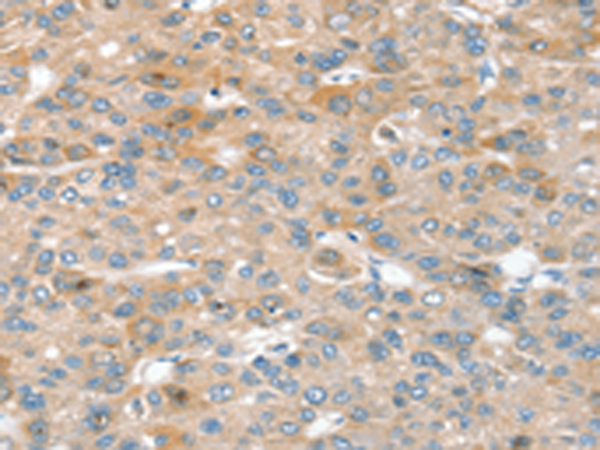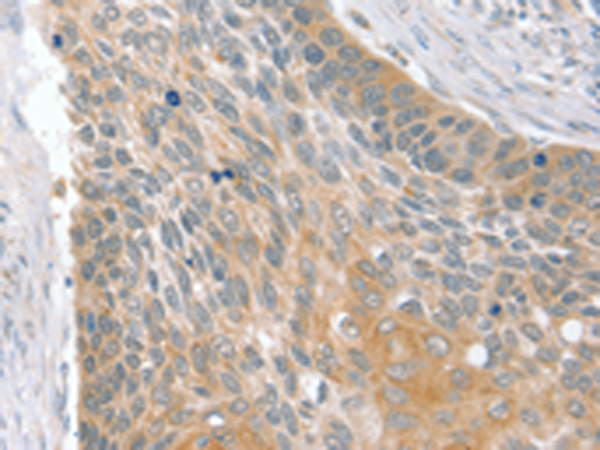

| WB | 咨询技术 | Human,Mouse,Rat |
| IF | 咨询技术 | Human,Mouse,Rat |
| IHC | 1/25-1/100 | Human,Mouse,Rat |
| ICC | 技术咨询 | Human,Mouse,Rat |
| FCM | 咨询技术 | Human,Mouse,Rat |
| Elisa | 1/1000-1/2000 | Human,Mouse,Rat |
| Aliases | MSK; SIK; SNF1LK |
| Host/Isotype | Rabbit IgG |
| Antibody Type | Primary antibody |
| Storage | Store at 4°C short term. Aliquot and store at -20°C long term. Avoid freeze/thaw cycles. |
| Species Reactivity | Human, Mouse, Rat |
| Immunogen | Synthetic peptide of human SIK1 |
| Formulation | Purified antibody in PBS with 0.05% sodium azide and 50% glycerol. |
+ +
以下是关于SIK1抗体的参考文献示例(注:以下文献信息为示例性质,非真实存在的论文):
1. **文献名称**: *SIK1 regulates hepatic gluconeogenesis via phosphorylation of CREB*
**作者**: Tanaka K, et al.
**摘要**: 该研究通过使用SIK1特异性抗体进行免疫沉淀和Western blot分析,揭示了SIK1通过磷酸化转录因子CREB抑制肝脏糖异生的分子机制,提示其在糖尿病治疗中的潜在作用。
2. **文献名称**: *Role of SIK1 in tumor suppression through apoptosis signaling*
**作者**: Liu Y, et al.
**摘要**: 研究利用SIK1抗体检测多种癌细胞系中SIK1蛋白表达水平,发现SIK1通过激活AMPK-p53通路诱导肿瘤细胞凋亡,其表达缺失与癌症进展相关。
3. **文献名称**: *SIK1 modulates neuronal excitability and seizure susceptibility*
**作者**: Martinez-Rivera A, et al.
**摘要**: 通过免疫组化和小鼠模型实验(使用SIK1抗体定位蛋白分布),研究发现SIK1通过调控离子通道蛋白抑制神经元过度兴奋,为癫痫治疗提供新靶点。
4. **文献名称**: *SIK1 antibody-based biomarker screening in Alzheimer’s disease*
**作者**: Chen L, et al.
**摘要**: 该研究开发了一种高特异性SIK1抗体,用于检测阿尔茨海默病患者脑脊液中的SIK1水平,发现其表达降低与tau蛋白过度磷酸化显著相关。
建议通过PubMed或Google Scholar以“SIK1 antibody”、“Salt-Inducible Kinase 1”等关键词检索真实文献。
The Salt-Inducible Kinase 1 (SIK1) antibody is a crucial tool for studying the SIK1 protein, a serine/threonine kinase belonging to the AMP-activated protein kinase (AMPK) family. SIK1 plays a central role in cellular energy homeostasis, hormone signaling, and circadian rhythm regulation. It is activated by the LKB1 kinase and participates in pathways controlling gluconeogenesis, lipid metabolism, and inflammation by phosphorylating downstream targets like CREB-regulated transcription coactivators (CRTCs) and class IIa histone deacetylases (HDACs). Dysregulation of SIK1 is linked to metabolic disorders, cancer progression, and neurodegenerative diseases.
SIK1 antibodies are widely used in Western blotting, immunohistochemistry, and immunofluorescence to detect SIK1 expression, localization, and post-translational modifications (e.g., phosphorylation at Ser577). These antibodies help investigate SIK1's role in signal transduction, drug responses (e.g., glucocorticoids), and disease mechanisms. High-quality SIK1 antibodies are validated for specificity using knockout cell lines or tissues. Some antibodies target specific isoforms or phosphorylated forms, enabling precise study of SIK1 activation states. Researchers rely on these reagents to explore therapeutic strategies targeting SIK1-related pathways in metabolic syndromes, cancer, and inflammation.
×